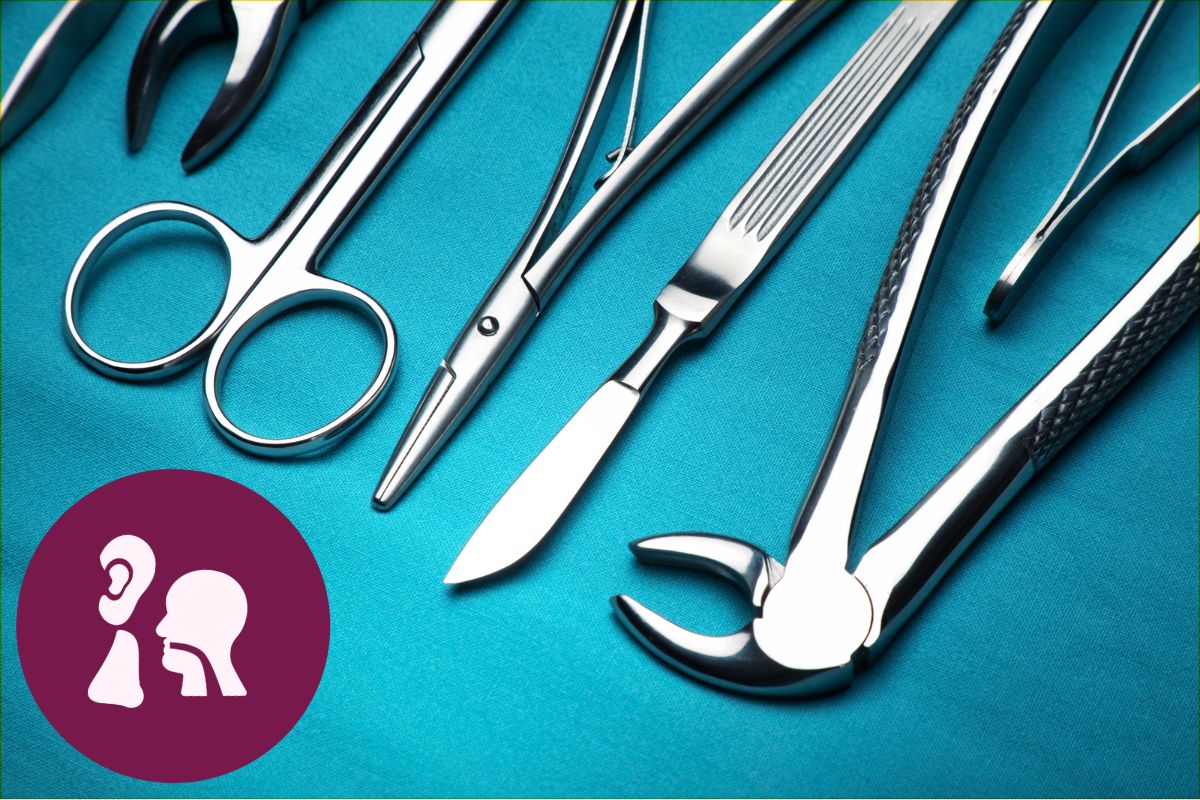INTRODUCTION
Doctors perform surgeries to cure or examine a pathological condition like injury, disease, improve organ function, appearance, repair ruptured areas. After a successful surgery, the patient will get a better quality of life. Doctors will utilise diagnostic testing to determine the primary problem before undergoing surgery. Tests help in providing a better picture of the internal conditions. An ENT specialist or otolaryngologist treats Ear, Nose and throat problems and perform ENT surgeries.

What is Ear Surgery, and why is it performed?
A qualified ENT specialist will perform an Ear Surgery. When an ENT specialist has determined that the disease, trauma, or patient condition cannot be cured by medication, they prefer surgical methods to treat. With the help of surgery, the doctor removes the infection or repairs or replaces the necessary tissues in the ear. ENT doctors daily treat numerous ear conditions like chronic bacterial & fungal infections, damage to the eardrum, hearing loss, and obstructive sleep apnea etc.
Who is a Paediatric ENT?
A Paediatric ENT doctor is a specialist who specialises in treating ENT problems in infants and children. Studies reveal that ENT issues in children are frequent till they attain 5. Paediatric ENT specialists treat ENT problems like Tonsils, Adenoids, Allergies, Tongue tie, Otitis media etc.
Different types of surgeries in ENT:
Different types of infections and injuries need different types of surgeries. Each surgery has its benefits and effects on the quality of life.
Cochlear Implant Surgery
What is cochlear implant surgery?
Cochlear implant surgery is performed to improve the hearing capacity of a patient. A cochlear implant is a small electronic device consisting of an external microphone and internal receiver components. A small incision is made behind the ear, and the internal part is implanted. The microphone on the outer part receives sound waves and transmits them to the internal receiver. The internal device receives the signals and transforms them into electrical impulses which are sent to the cochlea to stimulate the cochlear nerve. The brain identifies the waves and recognises the sound. A cochlear implant may not restore the natural hearing capacity, but it fixes your hard hearing.
Doctors suggest cochlear implant surgery when the hearing capacity of the patient does not improve with hearing aids. A cochlear implant is also recommended for people having hearing loss in both ears and other medical issues affecting hearing aid surgery.
A study published in 2018 stated that children who had tongue tie released at the age of five have seen improvement in speech, tongue movement and feeding skills. When the tongue tie is released, the child’s tongue articulation will improve his speech, sounds are clear and easy to understand.
Children and adults suffering from the hard or profound hearing will benefit from cochlear implant surgery. Surgery will gradually improve the quality of life in children and adults.
Ear Lobule Tear
what is an Earlobule surgery?
Earlobes are made up of soft fatty tissue, and they can easily be injured by trauma or injury. Earlobe split or hole reconstruction surgeries can be done in two ways, by surgical repair or Primary Suture Repair (PSR) and Glue-only. After examining the ear lobe, doctors will select the best surgery method.
Lobuloplasty surgery is performed to restore the saggy and torn ear lobes to their original state. It is a simple outpatient surgery completed in less than an hour. An ENT surgeon will perform the surgery under local anaesthesia by marking the area for a surgical incision and removing the enlarged tissue. It is a simple and painless procedure and an effective way to regain your natural appearance. In surgical methods, multiple earring holes or torn earlobes are restored to their natural shape.
Glue-only repair is a surgical method that uses a dermal adhesive to restore sagging earlobes. This surgery needs more skill and should be performed precisely.
Ear lobule tear surgery is performed to restore the ear shape and beauty of the face. Earlobes can easily be affected by external factors like trauma, injury, hard removal etc. Unfortunately there are no home remedies to restore saggy earlobes.
A study published in 2018 stated that children who had tongue tie released at the age of five have seen improvement in speech, tongue movement and feeding skills. When the tongue tie is released, the child’s tongue articulation will improve his speech, sounds are clear and easy to understand.
You can wear your favourite earrings, restore your previous posture of the ear, and gain some confidence.
Facial Palsy
what is facial palsy?
Facial palsy is a condition where the facial nerve is damaged temporarily or permanently, affecting facial movements. Facial palsy or bell’s palsy treatment differs from person to person, and the surgical procedure depends on the symptoms and the degree of facial paralysis.
There are diffferent surgical methods to treat facial palsy they are:
Transmastoid facial nerve decompression
It is the most common surgical method. This surgery is performed when the facial nerve is damaged near the tympanic or mastoid bone. The decompression technique is done over 180 degrees of the nerve’s circumference to treat facial palsy. In this procedure, doctors insert an interposition graft in place of the incus, and this helps in allowing more space for the nerve.
Middle fossa and Translabyrinthine facial nerve decompression
This surgery is performed when the facial nerve decompression extends to the labyrinthine nerve. The surgery is done by reaching through the middle fossa alone or including a transmastoid procedure. The combined procedure helps in curing trauma caused to the temporal bone.
Facial nerve grafting
The facial nerve controls all the facial movements on the face. The damage to the nerve causes difficulty in smiling and other facial movements. Immediate diagnosis saves the affected person from permanent facial paralysis. Doctors perform Facial nerve grafting when the facial nerve is damaged, and replacing the damaged nerve with a new nerve will restore the facial nerve movements.
Masseteric facial nerve transfer
The Masseteric facial nerve transfer procedure involves sewing the masseteric nerve and facial nerve. Doctors surgically connect the masseteric nerve to the buccal branch of the facial nerve to restore the patient’s facial movements and smile.
Facial palsy affects a person’s face, and it is difficult to make facial movements like a smile, frown and blink. Surgery and facial exercises after the surgery is the best method to treat and restore their facial expressions.
Restores all your facial movements, you can smile, blink, frown, and speak confidently.
Eustachian Tube Balloon Dilation
what is Eustachian Tube Balloon Dilation surgery?
Eustachian tube balloon dilation helps in curing people who are suffering from blocked ears. The treatment mainly depends on analysing the symptoms, how the negative pressure is created in the eustachian tube. The closed eustachian tube in the eardrum is cleared by a simple surgical procedure carried out by a specially designed endoscope. Using an endoscope doctor reaches out to the eustachian tube from the nose without any incision and then gently stretches the opening of the eustachian tube with the help of balloon dilation.
The surgery is safe, simple, and provides a quick solution for clogged ears.
Balloon dilation benefits people suffering from negative pressure and blocked ears. Balloon dilation will clear the negative pressure, ear pain, and clogging.
Hole in the Ear Drum
what is a Perforated Ear Drum?
When a hole forms on the Eardrum or tympanic membrane is called perforation and the condition is known as Perforated Eardrum. The tympanic membrane is a thin layer, from the middle ear sound waves will be received by this membrane in the form of vibrations and helps in recognising the sounds.
A hole in the eardrum occurs for many reasons. If left untreated, then it causes permanent hearing loss and leads to other ear infections. There are different types of surgeries to treat holes in the eardrum. The surgery depends on the hole number and type, severity of the hearing loss and any infection present in the ear.
Tympanoplasty
The surgery performed to repair a hole or perforation on the tympanic membrane is called tympanoplasty. In this surgery, the Earsurgeon uses a small piece of tissue from the patient’s body or graft to repair the perforated eardrum. The surgery takes at least 2 hours to complete.
Myringoplasty
Myringoplasty is performed for smaller perforations on the eardrum. The surgery completes in less than 30 minutes.
Ossiculoplasty
Doctors perform ossiculoplasty if the three bones in the middle ear are damaged. The bones are called ossicles and are replaced by prosthetics or a donor. General anaesthesia is given to the patient to perform the surgery.
The surgery for a hole in the eardrum is performed to restore the hearing capacity of people suffering from hard hearing. Perforated eardrums will lead to middle and inner ear infections, and doctors perform surgical procedures to remove them as a preventive method.
Restores your hearing capability, reducing the frequency of ear infections.
Mastoidectomy / Mastoid Exploration Ear Surgery
what is Mastoidectomy?
Mastoid is a bone present behind the ears and a part of the skull. It is filled with air cells and looks like a honeycomb. Infection to the mastoid cells leads to mastoiditis. If the severity of the mastoid infection is high, then Mastoidectomy is performed to clear the infection on the mastoid bone.
Mastoidectomy is performed in three different ways they are:
Simple mastoidectomy: an ENT specialist will remove the infected air cells present in the middle ear by opening the mastoid bone.
Radical mastoidectomy: if the infection present in the mastoid bone is very severe, then the surgeon will remove the eardrum, a part of the mastoid bone, and clean the ear canal. This procedure will clear the majority of the middle ear organs and preserve limited hearing capability.
Modified radical mastoidectomy: in this procedure, an ENT specialist will remove the mastoid cell infection and other infected organs, not all but some middle ear organs. The eardrum is rebuilt in this procedure and has better hearing than radical mastoidectomy.
Mastoidectomy surgery is performed to clear the infection present in the ear. If it is not treated in time, it may lead to vertigo, labyrinthitis, damage to the facial nerve, meningitis etc.
Surgery Prevents hearing loss, facial palsy, labyrinthitis, brain abscess, dizziness, etc.
Myringotomy Grommet
A Myringotomy grommet is performed to relieve the pressure created in the middle ear by the fluid. A minute slit is made behind the ear, and the ENT specialist sucks out any fluid that comes out. A small grommet is inserted into the eardrum. A grommet helps to maintain the airflow between the middle ear and the inner ear.
A Myringotomy grommet is performed to relieve the pressure created in the middle ear by the fluid. A minute slit is made behind the ear, and the ENT specialist sucks out any fluid that comes out. A small grommet is inserted into the eardrum. A grommet helps to maintain the airflow between the middle ear and the inner ear.
To eliminate recurring infections and earaches that are caused due to glue ear. Surgery relieves the symptoms that are caused by glue ear.
It provides better hearing, improves learning ability, and decreases middle ear infections caused by glue ears.
Pre auricular Pits & Sinus
What is a preauricular pit?
A preauricular pit or sinus is a minute hole present in front of the ear. It is formed during the developmental stage, and size varies from person to person. The sinus tract present below the skin is connected to the preauricular pit.
If the preauricular tract is prone to recurrent infections, an ENT specialist will surgically remove it. This is an outpatient surgery and completed in less than an hour.
No recurrent sinus tract infections, sinus infections and hearing loss.
Stapes Surgery
Stapes is the smallest bone in the ear. Surgical removal of stapes bone is called Stapedectomy. Otosclerosis is the main cause for stapedecotmy. People aged between 20-30 years may experience hearing loss because of Otosclerosis.
The stapes is a tiny bone in the ear, and it plays a prominent role in sending sound waves from the middle ear to the inner ear. The surgical removal of stapes bone is called stapedectomy. In stapedectomy, doctors remove the stapes bone or part of it and replace it with an artificial device. The surgery is completed in less than 2 hours. The artificial device does the work of stapes bone and helps in hearing.
Stapedectomy provides better hearing capability.
Thyroid Surgery
What is thyroid surgery?
Thyroid is a butterfly-shaped organ present in the neck. The surgical removal of the thyroid gland entirely or a part of it is called thyroidectomy.
There are three types of Thyroidectomies depending on the amount of thyroid gland removed; they are:
Total thyroidectomy: entire thyroid gland is removed
Hemi-thyroidectomy or thyroid lobectomy: half of the thyroid gland is removed
Isthmusectomy: the lobe present between the thyroid glands is removed
Thyroidectomy is performed surgically in three different ways they are:
- Conventional thyroidectomy: in this procedure, an ENT specialist will remove the thyroid gland by making an incision on the neck and remove it with surgical scissors and a scalpel. Bleeding and pain occur during the surgery.
- Transoral thyroidectomy: in this procedure, an incision is made inside the mouth instead of the neck.
- Endoscopic thyroidectomy: this procedure is called invasive surgery and is done using a small incision on the neck. A flexible camera with a light source guides the surgeon in dissecting the thyroid gland.
To treat goitre, enlargement of the thyroid
- Thyroid cancer
- Thyroid nodules
- Goitre
- Enlargement of Thyroid
Tonsils in Adults
Usually, people have a misconception about tonsils which occurs only in children. No tonsils can infect anyone irrespective of their age. Symptoms of tonsils in adults are different from children and need proper medication.
The different types of techniques that are followed to remove tonsils are:
- Coblation tonsillectomy: in this surgical procedure, the Tonsils are removed by destroying the tissue surrounded by tonsils that attach to the pharynx. The soft tissue is destroyed by the controlled technique called controlled ablation. Dr Shree Rao is an expert in this procedure and cured many patients using this method. It is less painful, has bloodless surgery, and is safe for kids.
- Radiofrequency or Laser energy: Radiofrequency or laser energy is used in this technique, both emitting heat. The heat produced is used to cut and seal the wound at a time during the surgery.
- Conventional method or Use of Scissors: This is the traditional method of treating Tonsils which uses scissors as a surgical instrument to remove tonsils. In this method, blood loss is seen, and the patient feels severe pain during the surgery. This procedure takes more time to cure than other surgical methods.
Tonsillectomy can improve the patient condition from
- Recurring tonsillitis
- Obstructive sleep apnea
- Tonsil stones
- Reduces severity of throat and bacterial infections

WHY CHOOSE EAR SURGEON?
Dr. Shree Cuddapah Rao is acclaimed as one of the best pediatric ENT specialists in Hyderabad. With 10+ years of deep domain experience in the field of ENT, she is the director at Dr. Rao’s ENT Super Specialty Hospital. She underwent specialized training in Rhinoplasty / Facial Plastic surgery at Singapore General Hospital, Singapore. She also underwent advanced training in cochlear implant surgery under Padmashri Dr. Milind V Kirtane and had a Fellowship in a cochlear implant. Having performed over 200 successful cochlear implants for patients worldwide, Dr. Shree Cuddapah Rao is also the recipient of several prestigious accolades in the domain of ENT.







